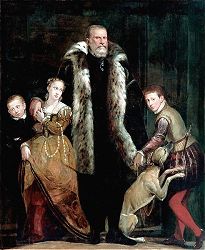 click to enlarge
click to enlarge |
|
PORTRAIT OF A FAMILY GROUP
Giovanni Antonio Fasolo
Italian, 1530-1572
SN 83, oil on canvas, c. 1561-65
From "The Pages"
ARTIST:
Fasolo was born in Mandello del Lario & died in Vicenza. Of Lombard origin, he was initially a pupil of Paolo Veronese & subsequently had a short but successful career as a fresco & portrait painter around Vicenza. He was employed as a minor assistant to Veronese in Venice, but emerged in his own right toward the end of the decade (1557-61), when he began producing stage designs for the Accademia Olimpica in Vicenza. He also executed fresco designs in several private country villas. He also designed altarpieces, although those lack the strength of his portraits and frescoes.
|
SUBJECT:
Unfortunately, nothing is known of the wealthy family represented in this ambitious portrait. Fasolo depended on precedents by his teacher, Veronese, for the complicated grouping, which seems to reveal the emotional lives as well as the status of the wealthy, probably noble, sitters.
PAINTING:
This work was originally attributed to Veronese. The family portrayed is dressed in extremely luxurious and fashionable clothing, but they don’t look very happy. The father presumably commissioned the painting and chose the way he wanted them portrayed, but one must wonder why he was satisfied with the result! The daughter seems sad and retrospective. One boy looks desperately unhappy, the other extremely apprehensive. Even the dog seems worried, and paws his master for reassurance.
The father projects a forceful presence, but his stern visage and protective arm around his daughter lead one to speculate that someone has just arrived to haul them all off to prison. Has the father incurred the wrath of the Doge? Are bailiffs pounding at the door? Where’s the mother?
HISTORIC CONTEXT: (Notes from Michele Scalera’s gallery walk)
The painting is unsigned and its’ authorship has been debated. Once the varnish was removed, some pentimente (ghosting) was visible: there seems to have been another, horizontal, painting underneath. On the right, under the boy’s head, one can make our a horse’s head. Behind the girl’s skirt is a vase and some ivy. There was something indistinguishable under the father’s head. The canvas is also seamed: why? The size hasn’t been althered. Was it a changed commission? Did someone fail to pay, so the work was painted over to save canvas? Who are they?
ringlingdocents.org
|
